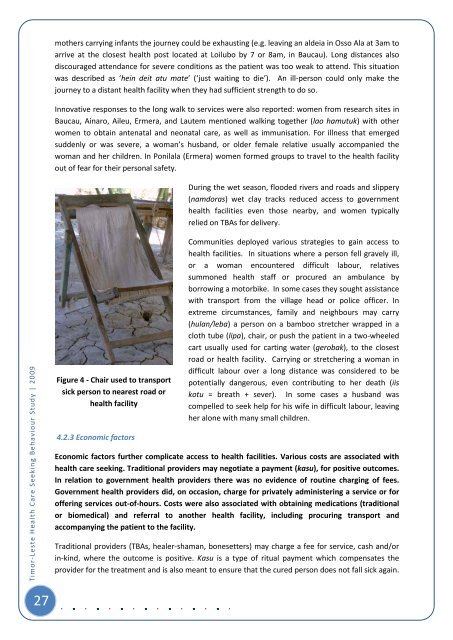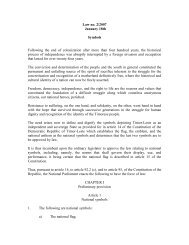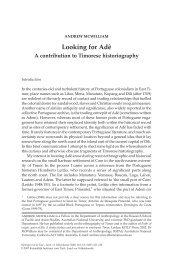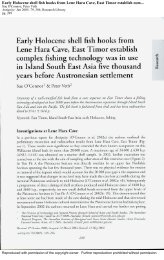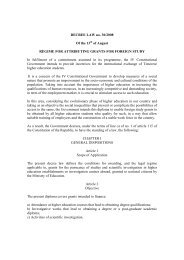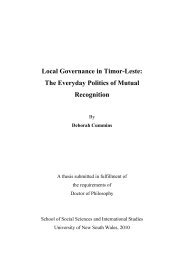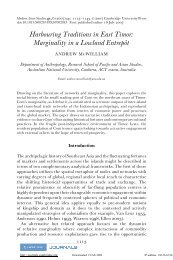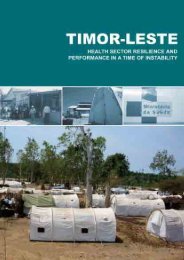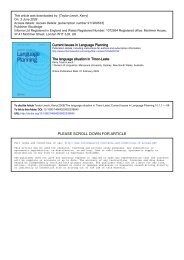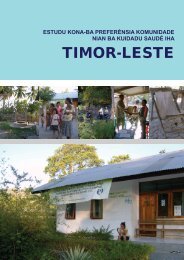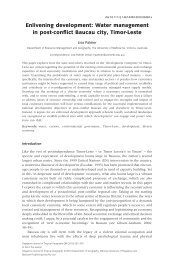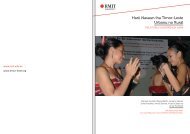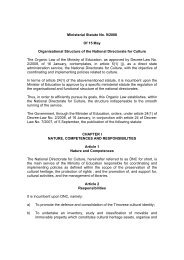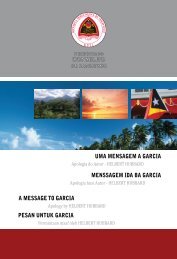Timor-Leste Health Care Seeking Behaviour Study - Secretaria de ...
Timor-Leste Health Care Seeking Behaviour Study - Secretaria de ...
Timor-Leste Health Care Seeking Behaviour Study - Secretaria de ...
- No tags were found...
You also want an ePaper? Increase the reach of your titles
YUMPU automatically turns print PDFs into web optimized ePapers that Google loves.
mothers carrying infants the journey could be exhausting (e.g. leaving an al<strong>de</strong>ia in Osso Ala at 3am toarrive at the closest health post located at Loilubo by 7 or 8am, in Baucau). Long distances alsodiscouraged attendance for severe conditions as the patient was too weak to attend. This situationwas <strong>de</strong>scribed as ‘hein <strong>de</strong>it atu mate’ (‘just waiting to die’). An ill-person could only make thejourney to a distant health facility when they had sufficient strength to do so.Innovative responses to the long walk to services were also reported: women from research sites inBaucau, Ainaro, Aileu, Ermera, and Lautem mentioned walking together (lao hamutuk) with otherwomen to obtain antenatal and neonatal care, as well as immunisation. For illness that emergedsud<strong>de</strong>nly or was severe, a woman’s husband, or ol<strong>de</strong>r female relative usually accompanied thewoman and her children. In Ponilala (Ermera) women formed groups to travel to the health facilityout of fear for their personal safety.During the wet season, floo<strong>de</strong>d rivers and roads and slippery(namdoras) wet clay tracks reduced access to governmenthealth facilities even those nearby, and women typicallyrelied on TBAs for <strong>de</strong>livery.<strong>Timor</strong>-<strong>Leste</strong> <strong>Health</strong> <strong>Care</strong> <strong>Seeking</strong> <strong>Behaviour</strong> <strong>Study</strong> | 2009Figure 4 - Chair used to transportsick person to nearest road orhealth facility4.2.3 Economic factorsCommunities <strong>de</strong>ployed various strategies to gain access tohealth facilities. In situations where a person fell gravely ill,or a woman encountered difficult labour, relativessummoned health staff or procured an ambulance byborrowing a motorbike. In some cases they sought assistancewith transport from the village head or police officer. Inextreme circumstances, family and neighbours may carry(hulan/leba) a person on a bamboo stretcher wrapped in acloth tube (lipa), chair, or push the patient in a two-wheeledcart usually used for carting water (gerobak), to the closestroad or health facility. Carrying or stretchering a woman indifficult labour over a long distance was consi<strong>de</strong>red to bepotentially dangerous, even contributing to her <strong>de</strong>ath (iiskotu = breath + sever). In some cases a husband wascompelled to seek help for his wife in difficult labour, leavingher alone with many small children.Economic factors further complicate access to health facilities. Various costs are associated withhealth care seeking. Traditional provi<strong>de</strong>rs may negotiate a payment (kasu), for positive outcomes.In relation to government health provi<strong>de</strong>rs there was no evi<strong>de</strong>nce of routine charging of fees.Government health provi<strong>de</strong>rs did, on occasion, charge for privately administering a service or foroffering services out-of-hours. Costs were also associated with obtaining medications (traditionalor biomedical) and referral to another health facility, including procuring transport andaccompanying the patient to the facility.Traditional provi<strong>de</strong>rs (TBAs, healer-shaman, bonesetters) may charge a fee for service, cash and/orin-kind, where the outcome is positive. Kasu is a type of ritual payment which compensates theprovi<strong>de</strong>r for the treatment and is also meant to ensure that the cured person does not fall sick again.27


